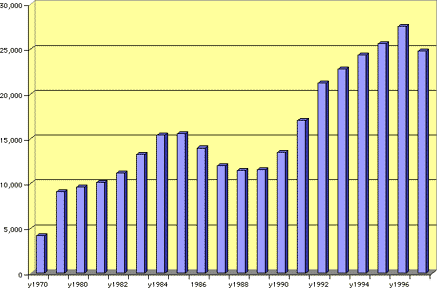|

SWEDEN
GDP (2003): $238.1 billion.
Annual growth rate (2003 expectation): 1.6%.
Per capita income (2003): $26,800.
Inflation rate (2003): 2.3%.
Budget: Income .............. $109 Billion
Expenditure ... $146 Billion
Main Crops: Grains, sugar beets, potatoes; meat, milk .
Natural Resources: Zinc, iron ore, lead, copper, silver, timber, uranium, hydropower .
Major Industries: Iron and steel, precision equipment (bearings, radio and telephone parts, armaments), wood pulp and paper products, processed foods, motor vehicles.
|
| NATIONAL GNP |
 |
Sweden is an industrial country. Agriculture, once accounting for nearly all of Sweden's economy, now employs less than 3% of the labor force. Extensive forests, rich iron ore deposits, and hydroelectric power are the natural resources which, through the application of technology and efficient organization, have enabled Sweden to become a leading producing and exporting nation.
The Swedish economic picture has brightened significantly since the severe recession in the early 1990s. Growth has been strong in recent years, and even though the economy slackened during the first half of 2001, the long-run prospects for growth remain favorable. The inflation rate is low and stable, with projections for continued low levels over the next 2-3 years. Since the mid-1990s the export sector has been booming, acting as the main engine for economic growth. Swedish exports also have proven to be surprisingly robust. A marked shift in the structure of the exports, where services, the IT industry, and telecommunications have taken over from traditional industries such as steel, paper, and pulp, has made the Swedish export sector less vulnerable to international fluctuations.
The government budget has improved dramatically--from a record deficit of more than 12% of GDP in 1993 to an expected surplus of .2% of GDP in 2003. The governmentÕs goal is to have a 2% surplus on average over a business cycle. The new, strict budget process with spending ceilings set by parliament, and a constitutional change to an independent Central Bank, have greatly improved policy credibility. This can be seen in the long-term interest rate margin versus the Euro, which is negligible. From the perspective of long term fiscal sustainability, the long-awaited reform of old-age pensions entered into force in 1999. This entails a far more robust system vis-ˆ-vis adverse demographic and economic trends, which should keep the ratio of total pension disbursements to the aggregate wage bill close to 20% in the decades ahead. Taken together, both fiscal consolidation and pension reform have brought public finances back on a sustainable footing. Gross public debt, which jumped from 43%t of GDP in 1990 to 78% in 1994, stabilized around the middle of the 1990s and started to come down again more significantly beginning in 1999. It is expected to be 49.2% by the end of 2004, and 48.8% by the end of 2005.
These figures show a quite remarkable improvement of the Swedish economy since the crisis in 1991-93, so that Sweden could easily qualify for membership in the third phase of the European Monetary Union. The government, however, decided for largely domestic political reasons that Sweden would not enter into the EMU from its start on January 1, 1999, but would keep its options open for entry at a later date. In its recent referendum on September 15th, Sweden decided against entry at this time.
In contrast with most other European countries, Sweden maintained an unemployment rate around 2% or 3% of the work force throughout the 1980s. However with high and accelerating inflation at this time, it became evident that such low rates were not sustainable, and in the severe crisis in the early 1990s the unemployment rate increased to more than 8%. In 1996 the government set out a goal of reducing unemployment to 4% in 2000. During 2000 employment rose by 90,000 persons, the greatest increase in 40 years, and the goal was reached in the autumn of 2000. The same autumn the government set out its new target--that 80% of the working age population would have a regular job by 2004. However, the target was not met due to a downturn in the economy, and because the population increase was greater than the employment increase. The Swedish government is now hoping that the target will be met by 2007.
Eighty percent of the Swedish labor force is unionized. For most unions there is a counterpart employer's organization for businesses. The unions and employer organizations are independent of both the government and political parties, although the largest federation of unions, the National Swedish Confederation of Trade Unions (LO), always has been linked to the largest political party, the Social Democrats.
There is no fixed minimum wage by legislation. Instead, wages are set by collective bargaining. Current labor contracts generally run through the year 2003, and call for wage increases of about three percent annually.
The traditionally low-wage differential has increased in recent years as a result of increased flexibility as the role of wage setting at the company level has strengthened somewhat. Still, Swedish unskilled employees are relatively well paid while well-educated Swedish employees are low-paid compared to those in competitor countries. The average increases in real wages in recent years have been high by historical standards, in large part due to unforeseen price stability. Even so, nominal wages in recent years have been slightly above those in competitor countries. Annual wage increases have been roughly on European levels. |
|
|


